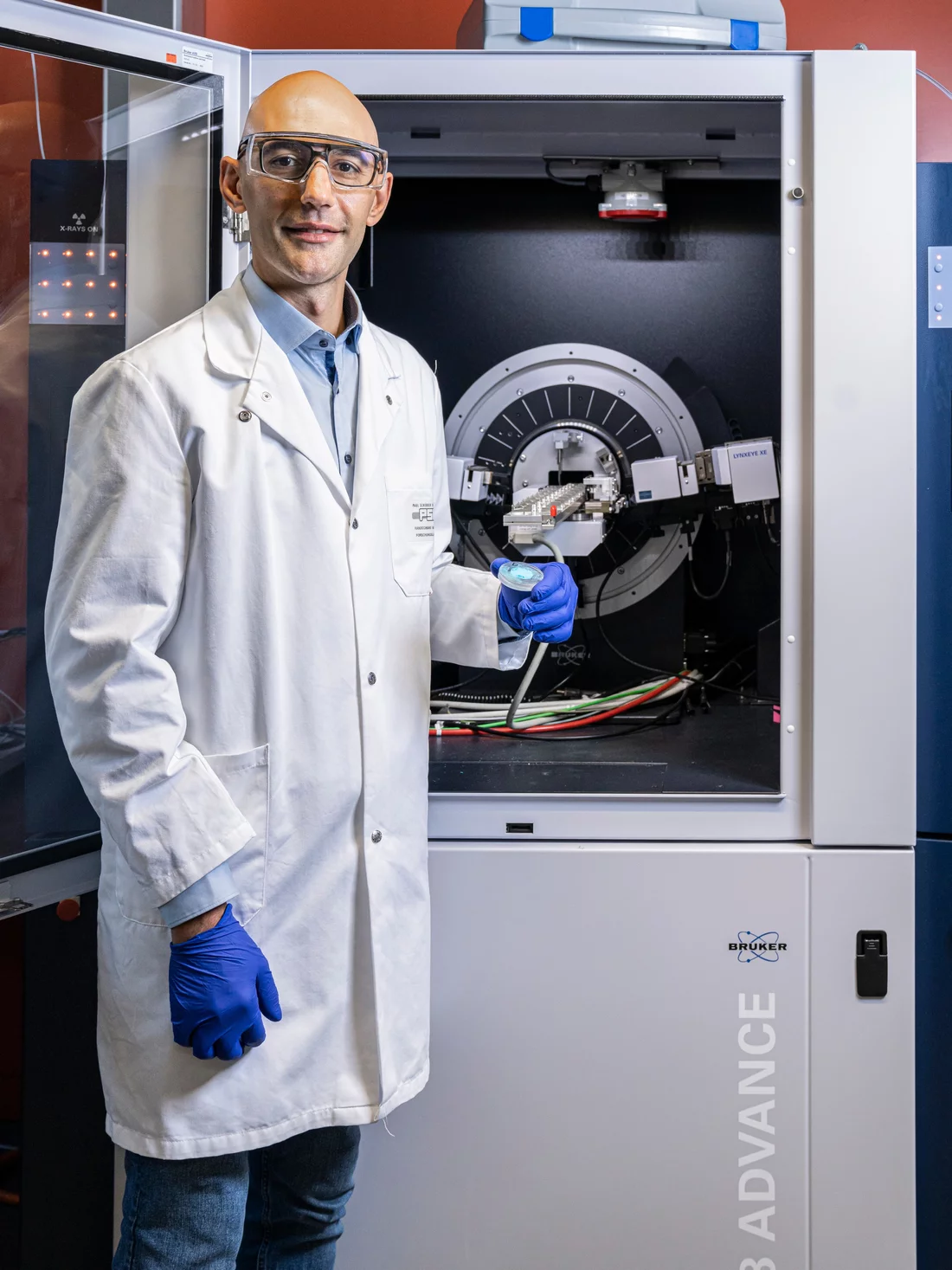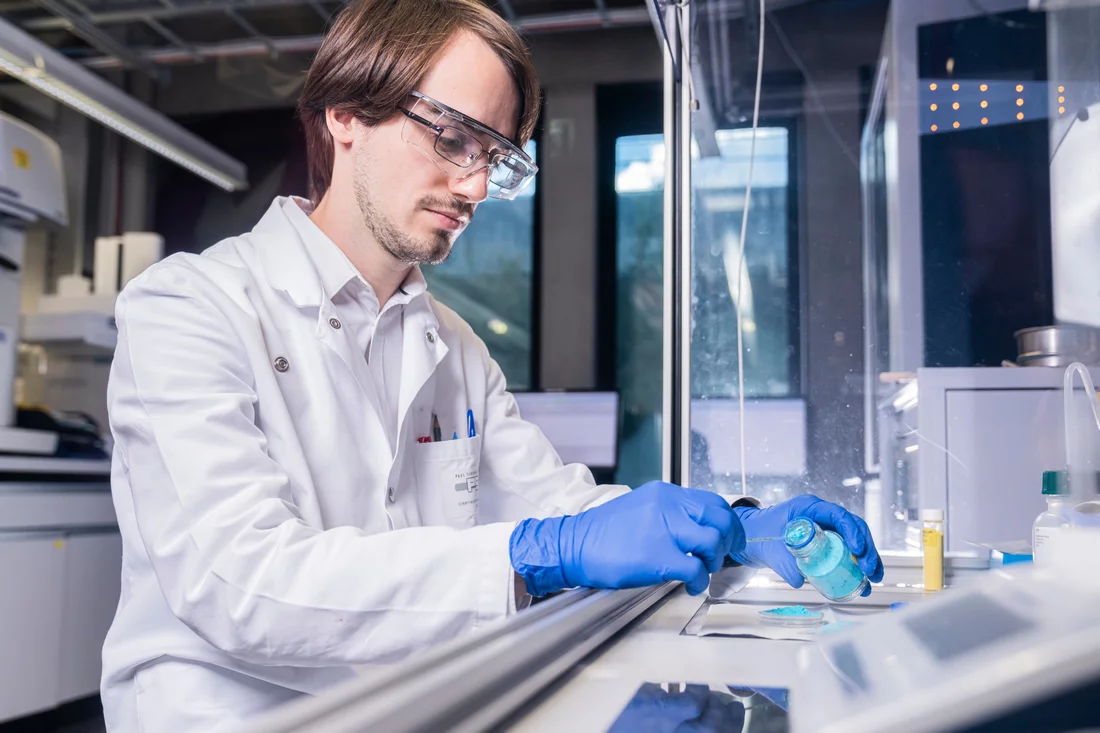PSI scientists are working with colleagues from the pharma company F. Hoffmann-La Roche on the development of a type of catalyst known as MOFs which could make drug production methods much more efficient. The two sides have just published a report on progress to date on the joint project in the Swiss scientific journal Chimia.
Catalysts are substances that promote a chemical reaction without being changed or consumed in the process. One area of application is the pharmaceutical industry. In this field especially, multi-step reactions are first needed to produce the required complex molecules that can be used as active substances in drug therapies. In addition, pharmaceutical production methods tend to generate relatively large amounts of waste products.
PSI scientists are working to solve these problems as part of a pioneering collaboration with the pharmaceutical firm F. Hoffmann-La Roche. In this project, they are investigating catalysts in the category known as MOFs, short for metal-organic frameworks. One of the main properties of these solids is their large pores and surface area. "One gram of MOF material can have a surface area comparable to several football pitches," says Marco Ranocchiari, a chemist at PSI and one of the joint project’s research team. The large pores contain active surfaces where molecules can dock onto.
Potential for more efficient pharmaceutical production
Process Mass Intensity, or PMI for short, is an important metric for the pharmaceutical industry. It measures the total mass input of all raw materials used in the production process compared with the mass of the desired end product. The PMI is therefore ultimately a measure of the quantity of waste produced. If the PMI is low, the production process is efficient. In the pharmaceutical industry, however, the PMI tends to be high because the complexity of the active substance molecules requires the use of multi-step production processes. With new drugs in particular, production often needs to ramp up quickly to ensure the active pharmaceutical ingredients (APIs) are available for clinical studies as soon as possible. As a result, efforts to improve the efficiency of the production process – and thus further reduce the PMI – typically only occur later in the drug development process.
"Our research with MOFs targets precisely this area: we want to help improve the PMI in the pharmaceutical industry. This will reduce the amount of waste in future and make API production more environmentally friendly," says Ranocchiari. "To be more succinct: the overriding purpose of our research project is to make drug production more efficient and more sustainable."
Advantages of MOFs
Apart from their large internal surface area, MOFs have other properties that make them ideal catalysts for pharmaceutical production. "We chemists have effectively twice as many possibilities for producing these substances and adapting them to their required purpose: we can use tools from both organic and inorganic chemistry, because metals are inorganic," explains Daniele Cartagenova, an organic chemistry specialist and member of Ranocchiari’s research group.
Another advantage of MOFs is that they remain as crystalline solids in the solution. The small crystals can be filtered out of the reaction mixture much more easily than the dissolved catalysts that are used as standard in the production of APIs.
And finally, the crystalline property of MOFs is also advantageous for their characterisation. Crystals are comparatively easy to study – specifically, the position of each atom in the crystal lattice can be determined and the MOFs can then be adapted accordingly. PSI scientists use an X-ray diffractometer for this. They also perform time-resolved measurements at the Swiss Light Source SLS based at PSI. "Here we can observe in real time exactly what happens during the catalytic process," Ranocchiari says.
Focus on a standard process
One of the most common processes used in API production is the Suzuki-Miyaura reaction, where a bond is formed between two carbon atoms: the C-C bond. The formation of the C-C bond is needed, among other things, to produce important clinical drugs such as navoximod or fenebrutinib. Navoximod is used to treat cancer, while fenebrutinib is used for autoimmune diseases such as multiple sclerosis and lupus erythematosus.
It is precisely this type of reaction that Ranocchiari and his team have therefore focused on over the last three years. They selectively modify MOFs and routinely analyse their structure and properties both before and after their use as a catalyst.
"My team and I like working with Roche because we can engage in important basic research that still has a practical purpose," Ranocchiari comments. "There is a chance that an application could emerge directly from our research that would benefit sick patients. And at the same time, we can help to introduce new and complementary procedures to reduce the amount of waste in pharmaceutical production. These two goals are highly motivating for us."
Text: Paul Scherrer Institute/Laura Hennemann
Further information
Look Inside a Chemical Reactor – article published 15 December 2020
Contact
Dr Ranocchiari
Head of Syncat Group, Energy and Environment Division
Paul Scherrer Institute, Forschungsstrasse 111, 5232 Villigen PSI, Switzerland
Telephone: +41 56 310 58 43, e-mail: marco.ranocchiari@psi.ch [German, English, Italian]
Original publication
Heterogeneous metal-organic framework catalysts for Suzuki-Miyaura cross coupling in the pharma industry
D. Cartagenova, S. Bachmann, J. A. Van Bokhoven, K. Püntener, M. Ranocchiari
Chimia, 24 November 2021
DOI: 10.2533/chimia.2021.972
Copyright
PSI provides image and/or video material free of charge for media coverage of the content of the above text. Use of this material for other purposes is not permitted. This also includes the transfer of the image and video material into databases as well as sale by third parties.


